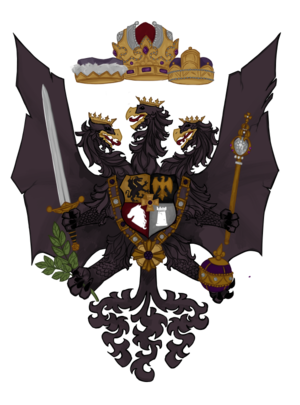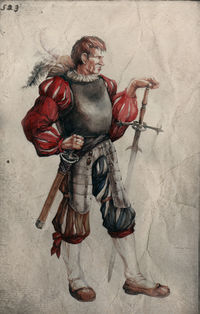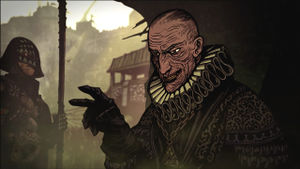Difference between revisions of "Holy Orenian Empire"
(→Provinces) |
Deminisher (talk | contribs) (Updated infobox) |
||
| Line 3: | Line 3: | ||
{| style="border:10px background:#FFFFFF; float:left;" width="50px" | {| style="border:10px background:#FFFFFF; float:left;" width="50px" | ||
|- style="height:5px; text-align:center" | |- style="height:5px; text-align:center" | ||
| − | |- class="wikitable" style="background:# | + | |- class="wikitable" style="background:#e4dcf6; text-align:center; margin-left: 10px;" |
| − | + | ! colspan="2" span style="font-size:Medium;" | '''Holy Orenian Empire''' <br> '''''Sacrum Orenorum Imperium''''' <br> '''1379-1595''' | |
|- | |- | ||
|- style="vertical-align:middle;" | |- style="vertical-align:middle;" | ||
| − | + | ! colspan="2" span style="height:100px" valign="top"| [[File:imperialorenia.png|300px|center]] | |
| − | [[File:imperialorenia.png|300px|center]] | ||
|- style="color:grey; text-align:center; vertical-align:center;" | |- style="color:grey; text-align:center; vertical-align:center;" | ||
| − | + | ! colspan="2" span style="font-size:x-small;" | ''Imperial coat of arms'' | |
| − | |- class="wikitable" style="background:#e4dcf6; text-align:center; margin-left: 5px;" | + | |- colspan="2" class="wikitable" style="background:#e4dcf6; text-align:center; margin-left: 5px;" |
| + | | | ||
| | | | ||
|- | |- | ||
| − | |<span style="font-size:small;">'''Capital''': [[Johannesburg]] | + | |<span style="font-size:small;">'''Capital''': || [[Johannesburg]] |
|- | |- | ||
| − | |- class="wikitable" style="background:#e4dcf6; text-align:center; margin-left: 5px;" | + | |- colspan="2" class="wikitable" style="background:#e4dcf6; text-align:center; margin-left: 5px;" |
| + | | | ||
| | | | ||
|- | |- | ||
| − | |<span style="font-size:small;"> '''Languages''': [[Common]] <br> [[High Imperial]] ''(only in official documents)'' <br> Hansetian ''(regional)'' <br> Raev Botch ''(regional)'' | + | |<span style="font-size:small;"> '''Languages''': || [[Common]] <br> [[High Imperial]] ''(only in official documents)'' <br> Hansetian ''(regional)'' <br> Raev Botch ''(regional)'' |
|- | |- | ||
| − | |- class="wikitable" style="background:#e4dcf6; text-align:center; margin-left: 5px;" | + | |- colspan="2" class="wikitable" style="background:#e4dcf6; text-align:center; margin-left: 5px;" |
| + | | | ||
| | | | ||
|- | |- | ||
| − | |<span style="font-size:small;"> '''Religion''': Canonism ''(1447-1459; 1467-1595)'' <br> Imperial Traditionalism ''(until 1447)'' <br> Ruskan Orthodoxy ''(1431-1447)'' <br> Reformed Communion ''(1459-1467)'' | + | |<span style="font-size:small;"> '''Religion''': || Canonism ''(1447-1459; 1467-1595)'' <br> Imperial Traditionalism ''(until 1447)'' <br> Ruskan Orthodoxy ''(1431-1447)'' <br> Reformed Communion ''(1459-1467)'' |
|- | |- | ||
| − | |- class="wikitable" style="background:#e4dcf6; text-align:center; margin-left: 5px;" | + | |- colspan="2" class="wikitable" style="background:#e4dcf6; text-align:center; margin-left: 5px;" |
| | | | ||
| + | | | ||
| + | |- | ||
| + | |<span style="font-size:small;"> '''Government''': || Hereditary absolute monarchy | ||
|- | |- | ||
| − | |<span style="font-size:small;"> ''' | + | |<span style="font-size:small;"> '''Founder''': || Godfrey I |
|- | |- | ||
| − | | | + | |- colspan="2" class="wikitable" style="background:#e4dcf6; text-align:center; margin-left: 5px;" |
| + | | | ||
| + | | | ||
|- | |- | ||
| − | |- class="wikitable" style="background:#e4dcf6; text-align:center; margin-left: 5px;" | + | |<span style="font-size:small;">'''Historical Era''': || Coronation of Godfrey (1379) <br> Partition of Kingston (1426) <br> Coronation of Sigismund (1431) <br> House Chivay and the Third Empire (1456) <br> Vibian Coup (1467) <br> Coronation of John I (1526) |
| + | |- | ||
| + | |- colspan="2" class="wikitable" style="background:#e4dcf6; text-align:center; margin-left: 5px;" | ||
| | | | ||
| + | | | ||
| + | |- | ||
| + | |<span style="font-size:small;"> '''Preceded by''': || [[Kingdom of Oren]] <br> [[Holy Oren Empire]] | ||
|- | |- | ||
| − | |<span style="font-size:small;">''' | + | |<span style="font-size:small;"> '''Succeeded by''': || [[Kingdom of Courland]] <br> [[Kingdom of Hanseti-Ruska]] |
|- | |- | ||
|} | |} | ||
Revision as of 16:50, 28 May 2017
| ||||||||||||||||||||||||||||||||||
- This page is about the Holy Orenian Empire. For Oren as a general concept, see Oren.
The Holy Orenian Empire, or simply Oren, (High Imperial: Sacrum Orenorum Imperium) was one of the largest and most powerful nation of humans or of any race upon the continent of Axios, and historically any past worlds as well. It was founded by the Exalted Godfrey, also known as Godfrey I. Its capital was the city of Johannesburg, and it adhered to the Church of the Canon as the state religion.
The language of the lands of the Holy Orenian Empire has always been Common, however High Imperial is often employed in official documents and among the bureaucracy and nobility, as well as in other parts of society with great Aeldinic influence. The current empire is in its fifth incarnation, known as the Fifth Empire to modern historians. The symbol of the Empire is the Horenic Dragon, with such motifs being employed in many of its standards and banners.
Contents
History
- Further Information: Timeline of Human history
Pre-Imperial
- Main Article: Kingdom of Oren
Before the rise of King Daniel of Oren, the pre-Godfreyian humanity was split between a variety of independent kings and dukes, not unified under any common banner. In fact, after the burning of Pontia in 1000, many human lords had deviated from the original Creatorist faith, some of whom had took up Aengulic worship. Many before King Daniel had attempted to take up the title as King of Man, most notably the Prince Baldwin IV of Balain in 1231 and the Horen-scion King Edmund of Mzen in 1235, both of whom were denied (Baldwin by his assassination en route to Jrent and Edmund by his defeat at the Battle of Harwock). King Edgar of Aaun, father of Daniel, had also attempted to claim the title, having the support of numerous lesser lords yet could not find the support among the fractured clergy.
The Phoenix Revolution
- See also: Phoenix Revolution
The First Empire
The Holy Orenian Empire was established on Asulon, following the expansion of the Kingdom of Renatus. Godfrey I of Horen returned to the Kingdom of Oren and retook his place on the throne. Under his rule he believed that all human kingdoms were to be reunited yet again under Orenian rule and so he began a series of conquests, beginning with the fall of Seventis after suffering an outbreak of the Plague. The nation of Salvus was then annexed having been defeated in a war that pitted them against a large coalition. When the Realm of Hanseti surrendered in war against Renatus, all of the human kingdoms were therefore reunited. The new unified nation of humans was to be the First Empire.
The Exodus
Collapse of the First Empire
The Second Empire
Established by the Exalted Sigismund, the last of the Prophets of the Canon, with his coronation in 1431, it was the Second Empire that reunified the disparate states of the old empire and restored the faith of the Creator to the human people, ending the last serious institutions of the pagan faith as well as crushing the ambitions of the Harrenites, who had up until that point played an integral role in human society. The Second Empire was dissolved with the death of Sigismund, with his successor and nephew, Henry I, refusing to adopt the style of emperor, instead returning to the previously held designation of King of Oren.
The Harrenite War
The Third Empire
The Third Empire is marked as the polity established by the famed war hero Peter Chivay, crowned as Peter I, after the assassination of the incumbent King Francis I of the Carrion dynasty in 1456, lasting until the deposition of Peter's successor Robert I in 1467 by Vibius de Sola. Heavily nationalistic and imperialistic, it was characterized by several wars fought towards the goal of total nonhuman subjugation, as well as the establishment of several military, political and social reforms. It was during the Third Empire that the concept of a centralized Imperial Army under the direct authority of the Crown first emerged.
The Fourth Empire
The Fifth Empire
The rise of John Frederick to the throne of Oren after the assassination of Guy de Bar is marked by historians as the Fifth Empire, or the fifth reestablishment of the Imperial Throne. The Fifth Empire is the current incarnation of the Empire, with the period being known as the Johannian Era. Currently six emperors have served during this period: John I, John II, John III, John IV, Robert II, and the current reigning Philip I. The Fifth Empire has seen the Eighteen Years' War, the Anarchy and the War of Orcish Submission between the Empire and the Kingdom of the Orcs.
Horen Restoration
See also: Horen Restoration
During the political instability after the bloody Dukes' War and the controversial election of Guy de Bar as King of Oren, the Aeldin-inhabitant Charles Henry Horen (known as the Old Pretender) created a plot in order to overthrow the Ashford monarch and place his own son to the Oren throne: the Horen-claimant John Frederick Horen. Main factors behind the plot included Guy's lack of support among the newly exiled Adrian nobility, such as the Houses of Vanir, Barbanov, and Vladov, and his waning favor with the non-Savoyard nobility (such as the removal of Publius Bracchus from the privy). Charles was joined in his endeavor by his brother-in-law (John Frederick's uncle, as well as Guy's father-in-law), Titus, Duke of Istria, the Aeldinic nobleman Helton Chivay, and the bishops Edmond de Montfort and Renauld of Metz. Later supporters included John, Count of Kvasz and Guy's nephew, Baldwin de Bar, who both joined after Guy's refusal to concede his second son Sergius de Bar to clerical trial for his actions in desecrating the Brelus Cathedral. Using Baldwin's personal connection with the House of Ashford, King Guy was brought forth unprotected into the royal palace gardens, where he was stabbed repeatedly by both Bishop Renauld and the priest Iosif of Roiye.
Days prior, John Frederick had landed upon Istria with a small host commanded by Athirius Roke, where he was joined by Duke Titus and Titus' youngest son, Vanderus de Sola. Before John reached the capital city of Felsen, Prince Gereon of Savoy (former King Olivier's brother and Guy's first cousin, one removed) had locked down the city and reestablished order while being declared Lord Regent.
Reign of John I
See also: John I, Holy Orenian Emperor
Eighteen Years' War
Main Article: Eighteen Years' War
The Eighteen Years' War, 1529 to 1547, was a series of punctuated conflicts waged between the Holy Orenian Empire and the Grand Kingdom of Urguan and their various allies for dominance over the other - dwarves wishing to see the reunified human empire divided and split, and humans desiring to break the Urguanite realm and protect against further dwarven incursions and military interference. The war dominated the reign of John I for the entire majority of his rule, only ending after his death at the Siege of Dunland in 1547.
The Anarchy
See also: Third Rurikid Uprising, Riga War, & Krajian Rebellion
The majority of the reign of John II saw a major backlash against Imperial authority, combined with negative post-war sentiments and his own rapidly declining mental health, a period which is given the title of the Anarchy. The period was not a set timeline of events, but multiple separate uprisings and plots in sequence during his rule. The Anarchy was ended shortly after the ascension of John III to the office of Prince Regent and eventually to the throne itself.
Culture and society
The Holy Orenian Empire is a human nation, and as such, revolves about the culture of mankind. Its ruling caste, the infamous nobles and ladies who descend from ennobled blood, come from predominantly Heartlander and Highlander backgrounds, and as such as created a melting pot swath of numerous identities, sets of life, and languages.
Politics
Army
Main Article: Imperial Army
Throughout the different periods of the Holy Orenian Empire, its military forces have adapted and changed dramatically from its original state. The Empire still relies upon levies of its vassal states and allies, however majority of its forces have been consolidated into one central military hierarchy and command. The current Imperial Army is headed by the princeps, which currently consists of two legions led by its respective legates. Lords of the Empire are typically given command of their own company, or if large enough, their own brigades within the legions, allowing the nobility to maintain control over their men without diminishing the strict chain of command which the current structure provides.
Succession
The Holy Orenian Empire follows strict semi-absolute primogeniture succession, where only males and sons of females may inherit. Succession would follow first to the firstborn son of the reigning Emperor, then to his sons, and the sons of his sons, and so on and so forth. The secondborn follows, continuing to all male members of the dynasty. If there are no males of the Imperial line, then sons of females would then follow. However, females cannot inherit the crown in their own right.
The succession of the Imperial Throne within the House of Horen is limited only to the progeny of Prince John, Duke of Marna, the secondborn son of Horen I, Holy Orenian Emperor, firstborn son of Exalted Godfrey.
Aristocracy
The upper classes of the Empire is dominated by the ancient noble aristrocracy- landowners and bureaucrats originating from large clans or families, typically called Houses. Membership into these houses or families are by blood only, and so the only prospect for a non-noble individual (called commoners) to raise themselves is either through marriage or by being elevated to nobility by the Holy Orenian Emperor himself. Majority of nobles own fiefs throughout the Empire, and it is through the nobility that the Empire grows and maintains its borders. Nobility deliver the Emperor taxes and soldiery in times of war, while the Emperor grants the nobility protection and secured succession.
Some of humanity's most important personas have come from the ancient noble houses, many of which can derive their lineage back generations.
Closed Council
The Closed Council is the highest authority within the Empire aside from the emperor himself, from whom they derive their power, managing the country's day-to-day affairs in his name. It consists of a body of highly skilled individuals, each of whom hold jurisdiction over a particular aspect of Imperial governance. The most powerful men in the realm, their jurisdiction is practically absolute, forming the instrument of government with the emperor at its core. They are chiefed by the Imperial Archchancellor, and are mostly aristocrats, however noble blood is not necessarily required for appointment, which is done singularly by choice of the monarch. To sit upon the Closed Council is the highest any individual without a blood claim to the throne can ascend in the Empire's complex political structure. Historically, the Closed Council has been known as the Privy Council, however the reforms of John III have led to its renaming with a more modern appellation.
Demographics
Humans make up the majority of the Empire, namely Highlanders and Heartlanders. Small minorities include Farfolk humans and Elves.
Provinces
Regarded by some detractors as aggressively expansionist, the Empire enjoyed the most success of any conquering power in history, adding several territories to its expanding borders. Incorporating them into the state's administrative structure as provinces, Imperials regarded these annexations as beneficial for their targets, bringing law, culture and peace to otherwise uncivilized lands. This sentiment is in part justified - the Orenian annexation of the High Princedom of Malinor in the latter part of the 15th century brought an extensive level of order and stable government to the otherwise anarchic and volatile wood and dark elves, allowing for a cultural revival and a resurgence in prosperity at the hands of pro-Orenian elven leaders such as Tristin Tresery and Artimec Camoryn. This reconstruction of civilization culminated in Oren's granting of independence to the elven states and creation of the Dominion of Malin in 1548, which has since acted as the Empire's most stalwart ally.
The Imperial counter-invasion of Urguan and Vandoria in the Eighteen Years' War led to the annexation of the provinces of Cascadia, Esterwick, Avar and Ard Ghorrock in Vailor. Similarly, the counter-invasion of the signatories of the Axis Treaty, a document proposing a coalition towards the goal of Oren's destruction, has led to the total destruction and absorption of the nation of the Dreadlands and the Orcish state of the War Uzg. Now stateless, the orcs have wandered aimlessly since, their former lands becoming incorporated into the province of New Cascadia.
Religion
The Church of the Canon was the state religion of the Holy Orenian Empire, with nearly every human within the Empire adhering to it. Small minorities of Owynism and Ruskan Orthodoxy, both branches of Canonism, also existed. Local groups of Iman al-Rashidun followers can be found in the Empire's enclaves near the Sultanate of Haria. Aengulic religions are considered heretical by the Church of the Canon, however numerous clerical orders in the past and present have been allied with the Empire or even sworn under its banner with promise of religious freedom.
Old paganistic faiths were once dominate in the humans, however majority of the old beliefs systems have died out after the refounding of the Empire by Exalted Sigismund and the defeat and exile of the Highlandic Old Faith worshiper King Lachlan Mor at the victorious Battle of Kralta.
Geography
The Empire was spread across two islands, Tahn and Asul, covering vast swathes of plains, forests and mountains. On the island of Tahn, the Kingdom of Hanseti-Ruska lies on the northern fringes, with the Archduchy of Lorraine to the south; bordering the Dominion of Malin, the Grand Kingdom of Urguan and the vassal Province of Haelun'or in the far west.
| |||||||||
| ||||||||||||||||||||||||||||||||


